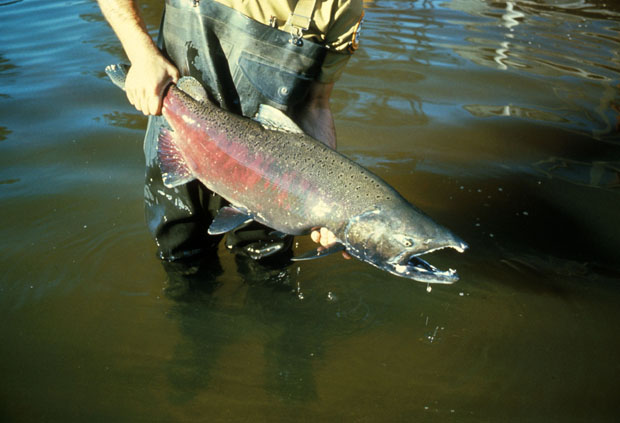Fishing prospects look promising for chinook in Washington’s ocean waters and the Columbia River, as well as for coho and pink salmon in areas of Puget Sound, according to state fisheries managers
OLYMPIA, Washington / March 02, 2015
[dropcap]T[/dropcap]he forecasts – developed by the Washington Department of Fish and Wildlife (WDFW) and treaty Indian tribes – for chinook, coho, sockeye, chum and pink salmon were released at a public meeting in Olympia today.
The forecasts mark the starting point for developing the 2015 salmon fishing seasons. The public is encouraged to participate throughout the process by attending various meetings and by using a new online commenting tool, said Ron Warren, fisheries policy lead for WDFW.
The commenting tool, a meeting schedule, salmon forecasts and information about the salmon season-setting process are available on WDFW’s website here . . .
Over the next several weeks, state and tribal co-managers will develop seasons that focus fishing opportunities on abundant hatchery and wild salmon populations, Warren said.
“Ensuring we meet our conservation objectives for depressed wild salmon stocks is the first step in establishing these fisheries,” Warren said. “That is always a challenge, but several of this year’s forecasts suggest we can provide some potentially great fisheries while meeting these goals.”
As in past years, salmon-fishing prospects in 2015 vary by area.
Columbia River:
[highlight color=yellow]…[/highlight]About 900,000 fall chinook are expected to return to the Columbia River in 2015. That would be the third largest run on record since 1938, said Ron Roler, Columbia River policy coordinator for WDFW.
[highlight color=yellow]…[/highlight]Roughly 70 percent of the chinook anticipated this year – or about 626,000 salmon – is expected to be “upriver brights” headed for areas above Bonneville Dam.
[highlight color=yellow]…[/highlight]The ocean abundance of Columbia River coho this year is expected to be nearly 777,000 fish, down from 964,000 in 2014.
[highlight color=yellow]…[/highlight]Washington’s ocean waters: About 255,000 hatchery chinook are expected to return this year to the lower Columbia River. Those salmon, which are known as “tules,” are the backbone of the recreational ocean chinook fishery.
[highlight color=yellow]…[/highlight]The forecast for returning coho also is strong though down somewhat from last year, said Doug Milward, ocean salmon fishery manager for WDFW.
[highlight color=yellow]…[/highlight]“Coho numbers are down about 20 percent from 2014, but the forecast for lower river chinook is up slightly from last year,” Milward said. “Overall, anglers can look forward to more great fishing opportunities in the ocean this summer.”
Puget Sound:
[highlight color=yellow]…[/highlight]Another solid run of coho is expected to return to Puget Sound’s rivers this year. More than 891,000 coho, up 20,000 from last year, are forecast to return to Puget Sound.
[highlight color=yellow]…[/highlight]Central and south Sound are anticipated to be bright spots for coho, said Ryan Lothrop, Puget Sound recreational fishery manager for WDFW.
[highlight color=yellow]…[/highlight]The forecast for summer/fall chinook is down somewhat from last year with about 208,000 chinook returning, Lothrop said. Hatchery chinook make up the bulk of returning fish.
[highlight color=yellow]…[/highlight]More than 6.5 million pink salmon are expected to return to the Sound this year, which is comparable to the number that returned in 2013. Most pink salmon return to Washington’s waters only in odd-numbered years.
[highlight color=yellow]…[/highlight]“A large return of pink salmon provides another reason for anglers to get out on the water and, perhaps, bring someone new to the sport along with them,” Lothrop said.
[highlight color=yellow]…[/highlight]Meanwhile, the forecast of 165,000 sockeye still falls short of the 350,000 minimum needed to consider a recreational sockeye fishery for Lake Washington. Fishery managers, however, will consider sockeye fisheries in Baker Lake and the Skagit River, Lothrop said.



